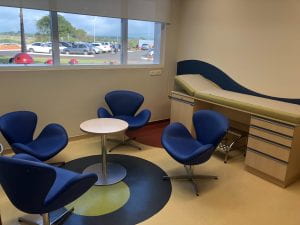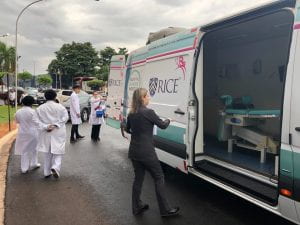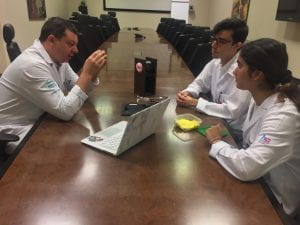The trip to Brazil went by super smoothly. We left Houston on Friday, May 31st, landed in Sao Paulo the following Saturday, caught our connecting flight to São José do Rio Preto, and drove about an hour to Barretos. Before I knew it, I was handed the keys to my apartment and unpacking my bags. The fact that I was leaving to Brazil didn’t hit during training, or when I went to the Brazilian consulate to get my visa, or when I was packing my bags, or when we took off to São Paulo. The news actually set in when Diego and I stopped at a TGI Fridays (Yes! They have those in Brazil!) to pick up lunch before our connecting flight to São José do Rio Preto. As we sat down, I felt pretty comfortable. I’d survived a ten hour flight surrounded by native Portuguese speakers and I could rely on my Spanish to get by if I really needed to. Boy, was I wrong!
Once we were seated, a waiter came to our table to take our orders. “E aí?” (“What’s up?”) Diego and I both froze and looked at each other to make the next move. That’s where it hit. I wracked my brain to come up with a cool response in Portuguese but the best I could do was an awkward half-smile. Diego finally said “Tudo bom!” but that didn’t seem to be enough for our waiter who was giggling to himself watching us squirm. Thankfully he put us out of our embarrassment and went on to take our order. On paper, this might not strike you as a super humiliating experience but I definitely left lunch humbled.
I am not someone who is very comfortable with failure. Actually, it’s one of the things I fear the most. While the rest of our interactions with the waiter went much more smoothly, I definitely left lunch with a little sneak-peek into the kind of little “failures” I’d have to become comfortable with. In my last blog post, I promised myself I would work towards welcoming and accepting my mistakes with open arms. In my case, it’s much easier said than done but I really tried adopting this attitude going into the first week and it worked!
The first couple of days at Hospital de Amor were a whirlwind. Ms. Carol (the AMAZING lady responsible for us having furnished apartments, lab coats, and scheduling our next two months) met us outside of our apartment complex at 8:30 AM on Monday, June 3rd and we were off to a day filled with hospital tours and meetings. In order to become more comfortable speaking the language, we requested that the tours be in Portuguese. Some background, Hospital de Amor has about eight, state-of-the-art buildings scattered around Barretos which pertain to various aspects of medical care from research, treatment, housing patients, and manufacturing of medical devices such as prosthetics.
We began with a tour of the Molecular Oncology Research Center with Dr. Rui Reis. The research labs were super neat and well equipped. Diego actually noticed how similar some of the labs were to the ones we knew in the Bioscience Research Collaborative in Houston. Dr. Silvia Prioli then showed us around the Prevention Institute and Mobile Unit Factory. I was ecstatic to see the mobile unit in person since the concept seemed so foreign yet intuitive to reaching patients from very rural communities. The mobile units were equipped with an examination table with stirrups, running water, and other medical devices and tools. The vans travel a couple of times a week to collect samples from patients who, for physical and financial constraints, are unable to make the trip to Hospital de Amor. The samples are then taken from the patient and travel back to Barretos to be examined. As we went through each tour, I kept notes on potential personal projects for my time in Barretos. When I saw the mobile unit I immediately felt drawn to it as the focus of my project. Maybe we could work to consolidate large medical devices and incorporate them into the small van? Or maybe we could find a way to recycle water used in the van? I still have a lot of questions and curiosities regarding the mobile unit and hope I can explore it some more!
After touring the mobile unit, Ms. Giovanna Andruccioli showed us around the prosthetic factory and rehabilitation center. I thought it was super neat that the hospital had its own factory to manufacture prosthetics! While we were there, we saw the engineers at work taking measurements on patients and creating casts consultation rooms while other engineers were busy downstairs actually constructing the attachments. Prior to my trip, I remember a discussion I had with my mom, an engineer, about how probes could be placed onto the body to follow a patient’s movement and compare it to healthy, “baseline” movements in order to minimize rehabilitation time. I was SHOCKED to see similar technology was already implemented in the consultation area of the prosthetic factory. I felt like a kid in a candy store!! I look forward to meeting with the engineers who installed or designed the device.
On Tuesday, we toured the remainder of the hospital departments. The most impressive space to me thus far has definitely been the Children’s Cancer Hospital. It is no exaggeration when I say that the facilities of Hospital de Amor are beautiful and rival those found in the Texas Medical Center. The Children’s Cancer Hospital in particular was really something else. The Children’s Hospital was built to tailor to the specific needs of children and provide them with a comfortable, fun wonderland to distract them while enduring treatments. Children and their families travel from different corners of Brazil to seek treatment at there. When they arrive, they are free to use any of the playrooms (I think I counted about seven?), the movie room, the showers, or a grab a bite to eat at the Hospital’s restaurant free of charge. When we visited, there were also two clowns walking around entertaining the children with jokes and blowing bubbles. I wish I had pictures to show you all of just how elaborate the space was yet I chose against taking any in order to protect the privacy of the patients.

Consultation room in the Children’s Cancer Hospital. Each room comes equipped with a bed and an area for the doctor to discuss treatments with family members.
Something I noticed during each of the tours was the intrinsic desire of each nurse, doctor, and resident to make healthcare accessible and enjoyable to all. While I have only been in Barretos for a week, I can feel how locals simply love life. Their love for life coupled with the amazing healthcare available here combines to produce a humanistic approach to medicine that I have not seen in the United States. Here, accessible healthcare is not only a right but an entire experience. Hospital de Amor really sets the bar high in making patients’ circumstance as comfortable and as painless as possible through the array of amenities, research efforts, their dedicated staff, educational efforts, and even the color schemes used in waiting rooms.
On Wednesday, Diego and I met with Dr. Vinicius Vazquez to discuss the WounderWoman device. While Dr. Vazquez seemed interested in the concept of the device, he identified problems with its ability to apply sufficient negative pressure. We believe the lacking suction could be caused by the weak pressure gauge, the battery, the physical circuit implemented in the device, or the weak tubing used which collapses when too much pressure is applied inhibiting proper suction. Later, we met with Dr. Luis, a colorectal doctor, to present the ACE model and get his feedback. Dr. Luis was very eager and impressed by the device and immediately proposed three more applications for such an educational device. After a couple minutes of testing out the ACE model, Dr. Luis made a couple of suggestions for improvements which included changing the shape and size of the silicone inserts to enable doctors to really see into the model. Overall, the feedback was quite positive and I left the meeting feeling super fulfilled and excited to work on the edits and get more input.
Overall, I could not be happier with how my first week in Barretos went. I am beyond honored to be working and learning from experts in their fields who are truly motivated to providing world class healthcare to adults and children in need. I’m also very grateful to people like Carol, my apartment mates, and Dr. Ricardo’s wife and daughter for taking time out of their days to help me be it by showing me around the hospital, cooking me the best feijão I’ve ever had in my life, or showing Diego and I around Barretos. People here are so selfless and kind in everything they do.
Next week, I look forward to touring the local university (UNIFEB) and visiting their new makerspace as well as meeting with more doctors and hearing what issues and projects they would like for us to target!
Até logo,
Paula



